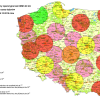Flybe DH8D near Isle of Man on Feb 7th 2014, severe clear air turbulence injures two
A Flybe de Havilland Dash 8-400, registration G-ECOH performing flight BE-402 from Birmingham,EN to Belfast City,NI (UK) with 71 passengers and 4 crew, was enroute in smooth conditions at FL220 near Isle of Man in visual meteorologic conditions, seat belt signs were off, when the aircraft encountered a sudden onset of severe turbulence, +2.75G followed by -0.43G, causing the airspeed to increase signficantly, the autopilot disconnected, and the aircraft climbed to FL225. The first officer, pilot flying, assumed manual control of the aircraft, reduced power and descended the aircraft back to FL220 reconnecting the autopilot about 25 seconds later. The turbulence reduced to and remained moderate until the crew initiated a descent. The aircraft continued to Belfast's City Airport for a safe landing. A flight attendant received serious injuries and taken to a hospital, a passenger received minor injuries.
The British AAIB released their bulletin releasing following discussion:
The aircraft probably encountered an area of Clear Air Turbulence (CAT) whilst in otherwise smooth air. CAT was not indicated on the forecast for the Isle of Man area, which was produced 24 hours in advance. The Met Office aftercast, using more up to date recorded meteorological data and data modelling, showed that some of the prevailing conditions, notably wind and temperature gradients, were conducive to the presence of CAT.
The operator’s passenger announcements include advice regarding the fastening of seatbelts, in case of sudden turbulence.
The AAIB reported, a flight attendant had been thrown off her feet in the cabin and received serious injuries. A doctor travelling as passenger provided first aid. A passenger received a minor injury. The flight attendant was taken to hospital after landing in Belfast.
The AAIB reported: "Recorded radar data for the area was available and examined for evidence of a possible wake turbulence encounter. No evidence was found of any other aircraft that could have had a significant effect on G-ECOH."
The AAIB summarized weather analysis: "The Met Office provided an aftercast, in which the available recorded data was reviewed, modelled and analysed to provide an assessment of the possibility of Clear Air Turbulence (CAT) in the area. The data showed that during the morning a deep area of low pressure over the Atlantic had moved rapidly to the east, building a transient ridge of high pressure over the United Kingdom (UK). There were two strong jetstreams (both over 100 kt) either side of the UK, which would have given rise to a large windshift. A wind data model at 400 hPa (FL240) showed that a large windshear would have been close to the Isle of Man at 0900 hrs and there were indications of a temperature gradient in the same area. Either or both of these factors can give rise to CAT. Analyses of the other available data suggested that cumulonimbus (CB) activity was not likely to have caused the turbulence and that this was a CAT event arising as a result of a large windshear in the vicinity of the Isle of Man."
Relevant Flight Data during turbulence encounter (Graphics: AAIB):
http://avherald.com/h?article=47a27592














Komentarze